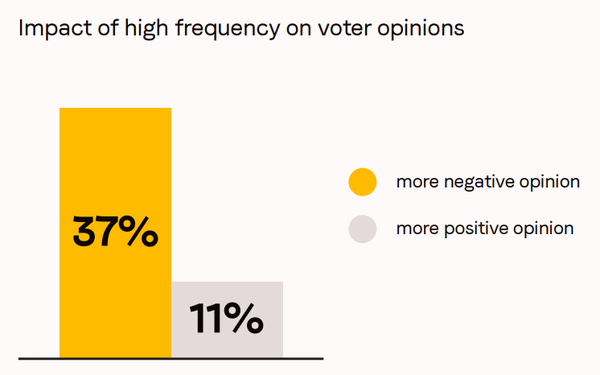Media Consumption Shifts Influence Voters' Receptivity To Political Ads, Study Finds
- by Laurie Sullivan @lauriesullivan, March 8, 2024

U.S. voters are more than twice as likely to be receptive to political advertising in media they use most when compared with other channels, but repetitive political advertising can create negative voter sentiment.
Some 37% of 6,262 U.S. respondents participating in a LoopMe survey that explored U.S. voter sentiment toward ad frequency and placement of political advertising indicated a distaste for viewing the same political ad too many times. The findings were mostly aggregated in late December 2023.
The data showed that high frequency rates are three times more likely to result in a more negative opinion of a message, especially for older voters.
Just 11% of respondents said high political advertising frequency would lead to a more positive opinion of a candidate, while 37% said high ad frequency would lead to a more negative opinion of a candidate.
advertisement
advertisement
Political ad frequency has the largest negative effect on persons 45 years of age and older.
The shift in media time continues toward digital channels. Some 54% of survey respondents spend the most media time with digital channels such as social, YouTube, streaming or mobile games. Those 45 and older use mobile games 60% more than YouTube and 30% more than streaming.
TV’s role in daily media consumption is shifting toward digital channels.
The majority of Americans are willing to consider opposing views in political ads. About 62% of respondents said they are open to seeing political advertising messages that they are in disagreement with.
Some 59% of social media and YouTube users were least receptive, and 75% of web surfers and 73% of podcast and radio listeners were most receptive.
The top five media channels that respondents use the most each day are television at 21%, social media at 20%, YouTube at 12%, streaming services at 11%, and mobile games at 11%.
Respondents who said they listen to podcasts and radio most were 176% more likely to be receptive to political ads on those channels.
For YouTube the receptivity boost was 117%, while for streaming the receptivity boost was 114%, but for social media, receptivity dropped to 82%.


